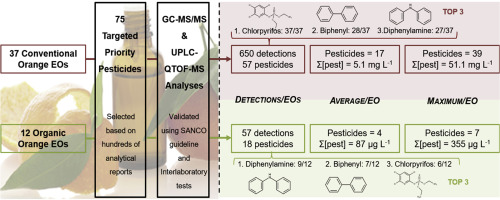当前位置:
X-MOL 学术
›
Anal. Chim. Acta
›
论文详情
Our official English website, www.x-mol.net, welcomes your
feedback! (Note: you will need to create a separate account there.)
Pesticides in essential oils: Occurrence and concentration in organic and conventional orange essential oils from eleven geographical origins
Analytica Chimica Acta ( IF 5.7 ) Pub Date : 2017-11-01 , DOI: 10.1016/j.aca.2017.08.039 Yoann Fillâtre , François-Xavier Gray , Céline Roy
Analytica Chimica Acta ( IF 5.7 ) Pub Date : 2017-11-01 , DOI: 10.1016/j.aca.2017.08.039 Yoann Fillâtre , François-Xavier Gray , Céline Roy

|
In this paper is described for the first time the application of both gas chromatography-tandem mass spectrometry (GC-MS/MS) and ultra performance liquid chromatography-quadrupole-time of flight-mass spectrometry (UPLC-QTOF-MS) to the determination of 75 priority pesticides in orange essential oils (EOs). The sample preparation consisted in a 10-fold dilution of orange EO followed by a direct injection for GC-MS/MS technique and a freeze-out step in the case of UPLC-QTOF-MS analysis. The analytical methods were validated using the SANCO criteria and gave reporting limits (RLs) of 10 μg L-1, 25 μg L-1, 50 μg L-1 and 100 μg L-1 for 57, 13, 4 and 1 pesticides, respectively. The analysis of four others EOs in the context of a proficiency test demonstrated very good performance and versatility of the methods with a detection rate of 100%, 97.8% of correct quantifications and no false negative. Then 49 orange EOs of known origin and quality were analysed using the standard addition procedure. It enabled to highlight significant matrix effects leading to differences in response factor up to 9.0 in GC-MS/MS and 53.1 in UPLC-QTOF-MS, between an orange EO sample to another. It was found that a conventional EO contained on average 17 pesticides for a total concentration of 5.1 mg L-1. Up to 29 different pesticides, 39 in the case of a concentrated EO, were detected in one sample and the sum of the concentration reached 51.1 mg L-1. Regarding the organic samples, none were free of pesticides but the contamination was found to be clearly lower than in conventional EOs. It was found that an organic orange EO contained on average 4 pesticides for a total concentration of 0.087 mg L-1.
中文翻译:

精油中的杀虫剂:来自 11 个地理来源的有机和常规橙子精油的含量和浓度
本文首次介绍了气相色谱-串联质谱(GC-MS/MS)和超高效液相色谱-四极杆飞行时间-质谱(UPLC-QTOF-MS)在测定中的应用。橙精油 (EO) 中的 75 种优先杀虫剂。样品制备包括将橙色 EO 稀释 10 倍,然后直接进样用于 GC-MS/MS 技术,并在 UPLC-QTOF-MS 分析的情况下进行冷冻步骤。使用 SANCO 标准对分析方法进行了验证,并给出了 57、13、4 和 1 种农药的报告限 (RL),分别为 10 μg L-1、25 μg L-1、50 μg L-1 和 100 μg L-1,分别。在能力测试的背景下对其他四种 EO 的分析表明,这些方法具有非常好的性能和多功能性,检测率为 100%,97。8% 的正确定量且无假阴性。然后使用标准添加程序分析了 49 种已知来源和质量的橙色 EO。它能够突出显着的基质效应,导致橙色 EO 样品与另一个样品之间的响应因子差异在 GC-MS/MS 中高达 9.0,在 UPLC-QTOF-MS 中高达 53.1。结果表明,常规 EO 平均含有 17 种农药,总浓度为 5.1 mg L-1。在一个样品中检测到多达 29 种不同的农药,在浓缩 EO 的情况下为 39 种,浓度总和达到 51.1 mg L-1。关于有机样品,没有一个不含农药,但发现污染明显低于传统 EO。结果表明,有机橙 EO 平均含有 4 种农药,总浓度为 0.087 mg L-1。
更新日期:2017-11-01
中文翻译:

精油中的杀虫剂:来自 11 个地理来源的有机和常规橙子精油的含量和浓度
本文首次介绍了气相色谱-串联质谱(GC-MS/MS)和超高效液相色谱-四极杆飞行时间-质谱(UPLC-QTOF-MS)在测定中的应用。橙精油 (EO) 中的 75 种优先杀虫剂。样品制备包括将橙色 EO 稀释 10 倍,然后直接进样用于 GC-MS/MS 技术,并在 UPLC-QTOF-MS 分析的情况下进行冷冻步骤。使用 SANCO 标准对分析方法进行了验证,并给出了 57、13、4 和 1 种农药的报告限 (RL),分别为 10 μg L-1、25 μg L-1、50 μg L-1 和 100 μg L-1,分别。在能力测试的背景下对其他四种 EO 的分析表明,这些方法具有非常好的性能和多功能性,检测率为 100%,97。8% 的正确定量且无假阴性。然后使用标准添加程序分析了 49 种已知来源和质量的橙色 EO。它能够突出显着的基质效应,导致橙色 EO 样品与另一个样品之间的响应因子差异在 GC-MS/MS 中高达 9.0,在 UPLC-QTOF-MS 中高达 53.1。结果表明,常规 EO 平均含有 17 种农药,总浓度为 5.1 mg L-1。在一个样品中检测到多达 29 种不同的农药,在浓缩 EO 的情况下为 39 种,浓度总和达到 51.1 mg L-1。关于有机样品,没有一个不含农药,但发现污染明显低于传统 EO。结果表明,有机橙 EO 平均含有 4 种农药,总浓度为 0.087 mg L-1。











































 京公网安备 11010802027423号
京公网安备 11010802027423号